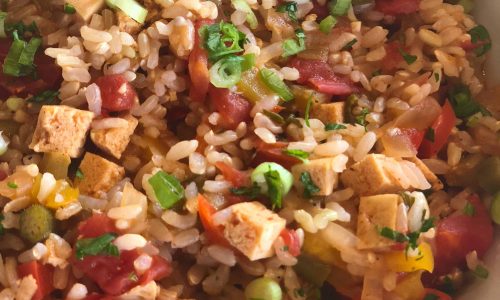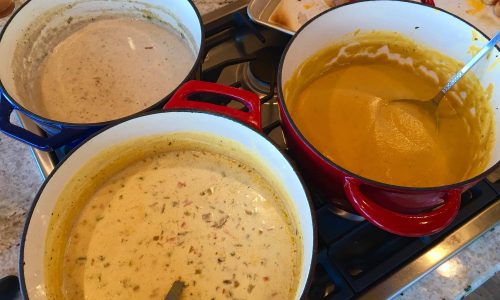I know this doesn’t look very appetizing but the point I wanted to make with the photo is to show the wide array of foods we tried in this class, and this isn’t even all of it. We are working hard on developing our palates and learning to recognize and use a variety of herbs, spices, nuts, oils, vinegars and condiments. We also conducted an experiment that demonstrated how cooking methods alter the flavors of food. Each person was assigned a different way to prepare raw onions. We all sampled each type of onion and here are my observations:
Raw onion: pungent, strong, stings
Raw onion soaked in water for 15 min: milder, less of a sting than raw
Raw onion soaked in apple cider vinegar: nice flavor, would taste great with a bowl of pinto beans and cornbread!
Steamed onion: very little flavor left
Sauteed in vegetable oil: sweeter but bland
Sauteed in olive oil: more flavorful
Sauteed in sesame oil: very sweet, nutty
Caramelized: sweeter, soft
Roasted (diced): dry, burnt flavor
Roasted whole: soft, sweet
Smoked: very flavorful, woody taste, would be great in salsa
I learned that soaking raw onion in water is an effective way to tone down the taste a bit.
I also like the idea of smoking onions and will try that myself in the electric smoker I have.
The next assignment was for each person to create a dry spice blend or paste to use on chicken, potato, and zuchinni. We were told to go out of our comfort zone and create a spice blend with ingredients we don’t usually use. No safe cumin, cayenne, paprika, garlic, salt, and pepper Bobby Flay rub tonight. I decided to use some Asian ingredients and create a paste, something I have not done before. I chose the following ingredients:
Lemongrass, basil, cilantro, lime leaf, sesame, jalapeno powder, ginger, salt, and green peppercorns.
I roasted some chicken generously coated with the paste and also deep-fried chicken coasted with the paste. I also coated cubes of potatoes with it and sauteed them, coated zuchinni with it and sauteed it as well.
We also had to make a rice pilaf as a group. This pilaf had to have spices and ingredients we don’t usually use. We toasted cumin and sage, sauteed the rice and onions, added chopped fresh tomatoes, sauteed poblano peppers, dried oranges, and fresh apples. Our pilaf was initially a little dry so water was added which made it too wet. Overall it was not very good and that’s putting it mildly…
We all sat together a a big table and passed around the various spice blends and pastes to try alone, on the chicken, on the potato, and on the zucchini. It was fascinating to discover how the blends changed. Some tasted good to horrible by itself and then when applied to chicken had little taste or tasted pretty good. Some tasted bland on chicken but flavorful on shrimp.
Some spices did not balance well together–anise and caraway, and some were overpowering.
We noted that the spice blends tasted stronger on the potatoes and zuchinni. It was amazing that the flavors changed on both the potatoes and zuchinni, sometimes in a positive way and sometimes not so positive. We tasted a LOT of strange flavors, but it was a great learning experience. My own spice blend actually tasted pretty good on the chicken, although I think the ground up lime leaf made it a bit too strong. The other flavors, particularly the basil, cilantro and lemongrass tasted really good on the chicken. I am anxious to experiment with spices, herbs, infused oils and vinegars instead of relying on the usual combinations.



